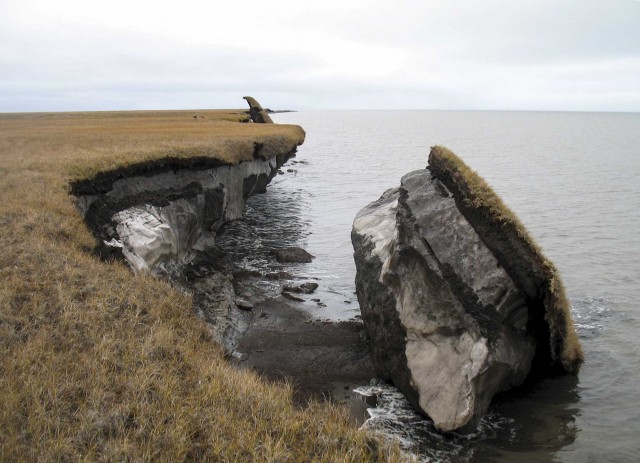
It has become a staple for news coverage of natural disasters: shocked residents, standing among the wreckage, promising to rebuild. But as climate change and sea level rise are permanently altering the landscape, it may not make sense to rebuild in precisely the same location. That reality has already arrived for many communities in northern Alaska, where the vanishing sea ice and permafrost have left entire towns at risk of being washed away. If the experience of those residents is anything to go by, we're woefully unprepared for the new reality.
A paper that will be released by PNAS details the challenges of what its authors call "climigration," the forced relocation of entire communities to safer ground. To date, the process has faced enormous hurdles, partially because there is simply no legislation that allows government agencies to pay for or coordinate the process—or even certify that it's conforming to federal regulations. At least partly as a result, the communities the researchers examined are still stuck in their deteriorating infrastructure.
A number of factors combined to make the native towns of northern Alaska exceptionally vulnerable to climate change. Originally, the area's inhabitants moved among locations with the changing seasons, which limited the amount of infrastructure in any one place. But mandatory education meant that communities coalesced around the sites where the state built schools. Since the schools were built with material brought to the area by barge, this mostly led to small towns built along the coast. These areas remained reliant on barges for fuel and other supplies.
The coastal location has left the communities extremely vulnerable to climate change, which is most dramatic in the Arctic (sea level rise has yet to be a significant factor). The land that many built on was permafrost, which rising summer temperatures made impermanent. The heat also eliminated a lot of coastal ice that used to act as a buffer to dissipate the energy of waves driven ashore by storms, which resulted in repeated floods that have destroyed the towns' infrastructure and literally washed some of the land out from under it.
In the three villages the authors examine in detail, the toll has been staggering. One community has been named an official FEMA disaster area five times, including three times within a two-year period. All areas have seen millions of dollars of federal aid spent trying to shore up the infrastructure, only to have it washed away when the next storm arrives. One town is currently lacking its barge ramp, sewage treatment plant, landfill, and fuel storage facilities.
Sensibly, the residents of 12 towns (out of the 31 most threatened) have voted to move the entire community to a new location. But desiring to do so and actually doing so turn out to be two entirely different things. So far, the best any of the three towns have managed is to build a few houses at a new site. None of the infrastructure needed to support a community has relocated yet.
Part of the problem is that the residents of the communities have focused on new locations that would allow them to continue their existing lives as identically as possible, but the locations they've chosen have frequently been vetoed by government agencies after studies have indicated that they would be vulnerable to melting permafrost. Just one of the towns has a new site that is approved by both the residents and authorities.
But if the government advises against new sites, it has not done much to aid the process. Again, there's no legal authority for it to do so. The legislation that enables disaster recover aid mostly covers individual critical events—with the exception of droughts, it has no mechanism for dealing with slow-moving disasters like climate change. It does have mechanisms for abandoning communities (mostly those built in flood plains), but those are based on the assumption that the former residents will simply integrate into some drier neighboring community. In northern Alaska, there aren't any such communities nearby.
As a result, money for protecting or rebuilding existing infrastructure, which would inevitably be destroyed again, may be available. Money to build where the infrastructure might survive generally isn't. The state's Alaska Climate Change Impact Mitigation Program provides some resources, and some federal agencies have shifted money from programs that weren't really designed for community migration, but the communities are still struggling to find a way to pay the costs of relocation. One is actually pursuing a lawsuit against fossil fuel companies in an attempt to come up with the cash.
Then there's the matter of getting the new buildings approved. The authors describe a typical challenge: "The National Environmental Protection Act requires designation of a federal lead agency, but the Stafford Act and other legislation provide no federal agency with authority to take a lead role in community relocation." Given the sites' extreme northern location, it would make sense that any new construction comes with modern insulation and fuel-efficient heating. In the absence of any central authority, though, issues like these risk slipping between the cracks.
It may be tempting to dismiss the northern Alaska experience as an extreme case that affects only a tiny population. But as the authors point out, about 10 percent of the world's population—along with trillions of dollars of infrastructure—is within a few meters of the ocean. The researchers explicitly point to the experience of New York and New Jersey in the wake of Hurricane Sandy as an example of the sorts of events that may force even wealthy, heavily populated areas to make hard choices about what to invest in protecting—and what to relocate. Unless our governments are prepared to handle those hard decisions, we're likely to repeat the chaotic and ad-hoc Alaskan experience on a completely different scale.
PNAS, 2013. DOI: 10.1073/pnas.1210508110 (About DOIs).
reader comments
99